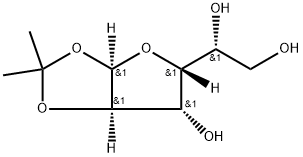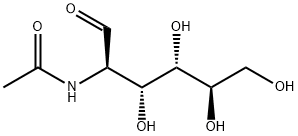Glucose-13C6
Synonym(s):D -Glucose-ul-13C;Dextrose-13C6;Labeled Glucose
- CAS NO.:110187-42-3
- Empirical Formula: C6H12O6
- Molecular Weight: 186.21
- MDL number: MFCD00037544
- SAFETY DATA SHEET (SDS)
- Update Date: 2024-11-19 23:02:33

What is Glucose-13C6?
Chemical properties
White Solid
The Uses of Glucose-13C6
Glucose-13C6 can be used in enzymic synthesis of cyclohexyl-α and β-D-glucosides
The Uses of Glucose-13C6
Glucose-13C6 is a simple sugar that is present in plants. A monosaccharide that may exist in open chain or cyclic conformation if in solution. It plays a vital role in photosynthesis and fuels the energy required for cellular respiration. D-Glucose is used in various metabolic processes including enzymic synthesis of cyclohexyl-α and β-D-glucosides. Can also be used as a diagnostic tool in detection of type 2 diabetes mellitus and potentially Huntington's disease through analysis of blood-glucose in type 1 diabetes mellitus.
The Uses of Glucose-13C6
D-Glucose-13C6 has been used:
- for de novo fatty acid (FA) synthesis
- as a component in tracing media for the analysis of stable isotope tracer
- in minimal media for recombinant protein production
- for cell suspension
What are the applications of Application
D-Glucose-13C6 is a monosaccharide present in plants, used as an internal standard for the quantification of D-(+)-glucose.
Biochem/physiol Actions
D-Glucose-13C6 functions as a tracer and helps to access glucose kinetics in vivo.
Properties of Glucose-13C6
| Melting point: | 150-152 °C(lit.) |
| storage temp. | Refrigerator |
| solubility | Methanol (Slightly, Heated, Sonicated), Water (Sparingly, Sonicated) |
| form | Solid |
| color | White to Off-White |
| optical activity | [α]25/D +52.0°, c = 2 in H2O (trace NH4OH) |
Safety information for Glucose-13C6
| Signal word | Warning |
| Pictogram(s) |
 Exclamation Mark Irritant GHS07 |
| GHS Hazard Statements |
H302:Acute toxicity,oral H315:Skin corrosion/irritation H319:Serious eye damage/eye irritation H335:Specific target organ toxicity, single exposure;Respiratory tract irritation |
| Precautionary Statement Codes |
P261:Avoid breathing dust/fume/gas/mist/vapours/spray. P280:Wear protective gloves/protective clothing/eye protection/face protection. P301+P312:IF SWALLOWED: call a POISON CENTER or doctor/physician IF you feel unwell. P302+P352:IF ON SKIN: wash with plenty of soap and water. P305+P351+P338:IF IN EYES: Rinse cautiously with water for several minutes. Remove contact lenses, if present and easy to do. Continuerinsing. |
Computed Descriptors for Glucose-13C6
| InChIKey | WQZGKKKJIJFFOK-NYKRWLDMSA-N |
New Products
4-Fluorophenylacetic acid 4-Methylphenylacetic acid N-Boc-D-alaninol N-BOC-D/L-ALANINOL Tert-butyl bis(2-chloroethyl)carbamate 3-Morpholino-1-(4-nitrophenyl)-5,6-dihydropyridin- 2(1H)-one Furan-2,5-Dicarboxylic Acid Tropic acid S-2-CHLORO PROPIONIC ACID ETHYL ISOCYANOACETATE 2-Bromo-1,3-Bis(Dimethylamino)Trimethinium Hexafluorophosphate (6-METHYL-[1,3]DITHIOLO[4,5-b]QUINOXALIN-2-ONE INDAZOLE-3-CARBOXYLIC ACID 4-IODO BENZOIC ACID (2-Hydroxyphenyl)acetonitrile 4-Bromopyrazole 5,6-Dimethoxyindanone 2-(Cyanocyclohexyl)acetic acid 4-methoxy-3,5-dinitropyridine 2-aminopropyl benzoate hydrochloride 1-(4-(aminomethyl)benzyl)urea hydrochloride diethyl 2-(2-((tertbutoxycarbonyl)amino) ethyl)malonate tert-butyl 4- (ureidomethyl)benzylcarbamate Ethyl-2-chloro((4-methoxyphenyl)hydrazono)acetateRelated products of tetrahydrofuran




![4-O-BETA-D-[UL-13C6]GLUCOPYRANOSYL-D-[UL-13C6]GLUCOSE](https://img.chemicalbook.in/)
![BETA-D-[UL-13C6]FRUCTOFURANOSYL ALPHA-D-[UL-13C6]GLUCOPYRANOSIDE](https://img.chemicalbook.in/CAS/GIF/41055-68-9.gif)
![4-O-BETA-D-GALACTOPYRANOSYL-D-[UL-13C6]GLUCOSE](https://img.chemicalbook.in/)
![ALPHA-D-[UL-13C6]GLUCOPYRANOSYL 1-PHOSPHATE DICYCLOHEXYLAMMONIUM SALT, MONOHYDRATE](https://img.chemicalbook.in/)
You may like
-
 D-Glucose-13C6 CAS 110187-42-3View Details
D-Glucose-13C6 CAS 110187-42-3View Details
110187-42-3 -
 D-Glucose-13C6 CAS 110187-42-3View Details
D-Glucose-13C6 CAS 110187-42-3View Details
110187-42-3 -
 1975-50-4 98%View Details
1975-50-4 98%View Details
1975-50-4 -
 2-HYDROXY BENZYL ALCOHOL 98%View Details
2-HYDROXY BENZYL ALCOHOL 98%View Details
90-01-7 -
 2-Chloro-1,3-Bis(Dimethylamino)Trimethinium Hexafluorophosphate 221615-75-4 98%View Details
2-Chloro-1,3-Bis(Dimethylamino)Trimethinium Hexafluorophosphate 221615-75-4 98%View Details
221615-75-4 -
 61397-56-6 CIS BROMO BENZOATE 98%View Details
61397-56-6 CIS BROMO BENZOATE 98%View Details
61397-56-6 -
 14714-50-2 (2-Hydroxyphenyl)acetonitrile 98+View Details
14714-50-2 (2-Hydroxyphenyl)acetonitrile 98+View Details
14714-50-2 -
 118753-70-1 98+View Details
118753-70-1 98+View Details
118753-70-1